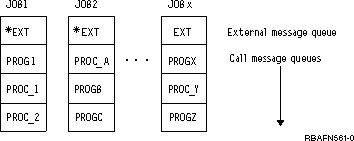All messages on the system are sent to a message queue.
The system user or program associated with the message queue receives the message from the queue. Similarly, a reply to a message is sent back to the message queue of the user or program requesting the reply.
The following diagrams show the message queues supplied by IBM®. A message
queue is supplied for each display station (where DSP01 and DSP02 are display
station names) and each user profile (where BOB and RAY are user profile names): 
Job message queues are supplied for each job running on the system. Each
job is given an external message queue (*EXT) and each call of an OPM program
or ILE procedure within the job has its own call message queue.
Message queues are also supplied for the system history log (QHST) and
the system operator (QSYSOPR):
These message queues are used as follows:
- Workstation message queues are used for sending and receiving messages between workstation users and between workstation users and the system operator. The name of the queue is the same as the name of the workstation. The queue is created by the system when the workstation is described to the system.
- User profile message queues can be used for communication between users. User profile message queues are automatically created in library QUSRSYS when the user profile is created.
- Job message queues are used for receiving requests to be processed (such as commands) and for sending messages that result from processing the requests; the messages are sent to the requester of the job. Job message queues exist for each job and only exist for the life of the job. Job message queues consist of an external message queue (*EXT) and a set of call stack entry message queues.
- System operator message queue (QSYSOPR) is used for receiving and replying to messages from the system, display station users, and application programs.
- The history log message queue is used for any job in the system to have a record of high-level system activities.
In addition to these message queues, you can create your own user message queues for sending messages to system users and between application programs.